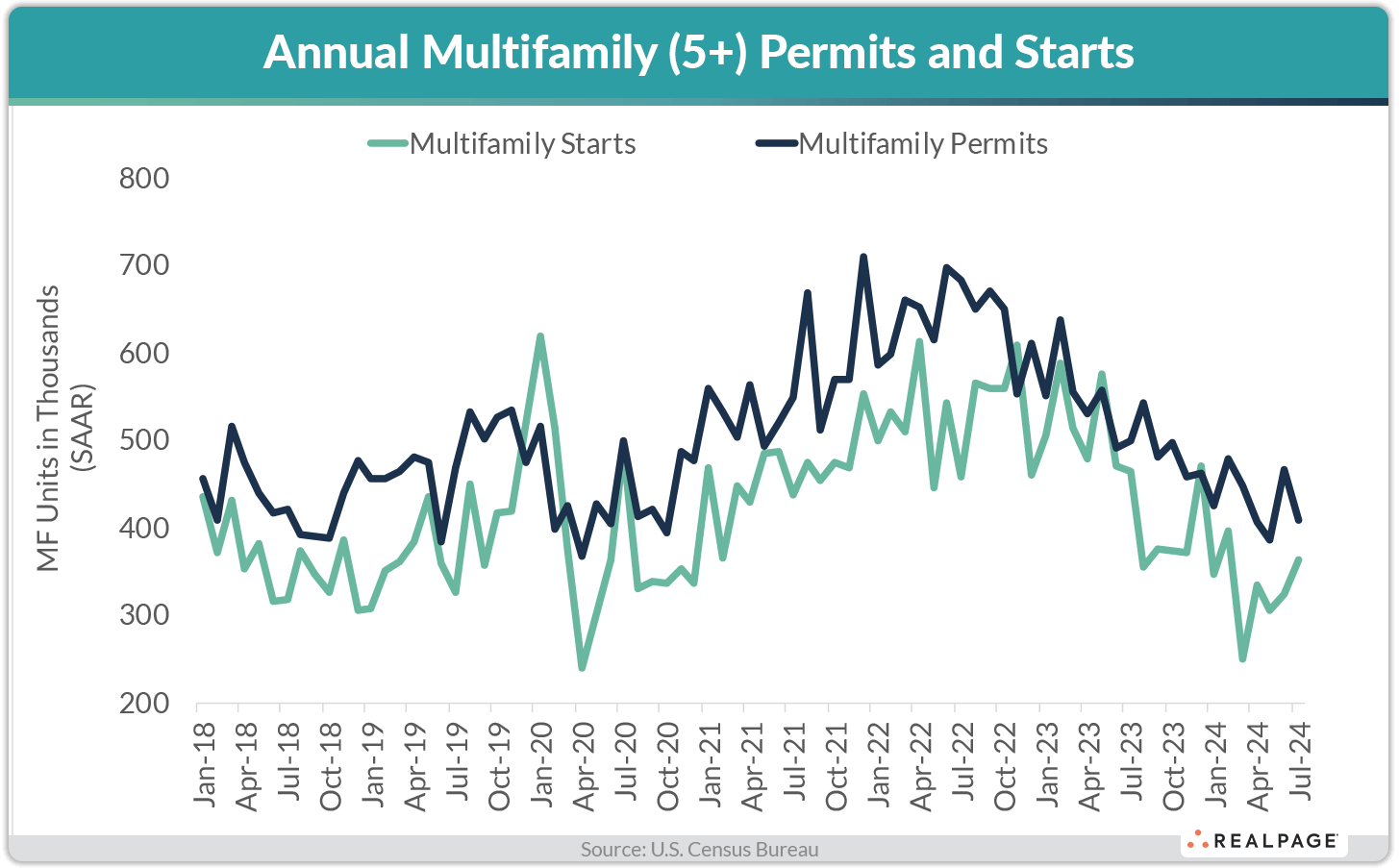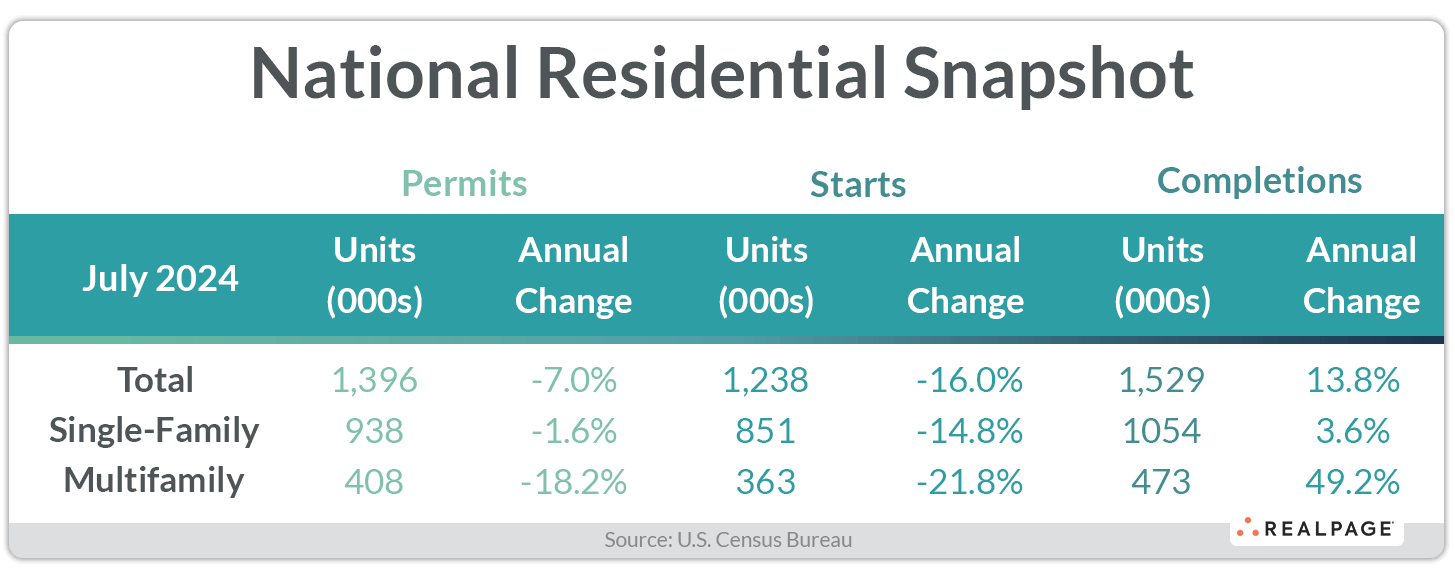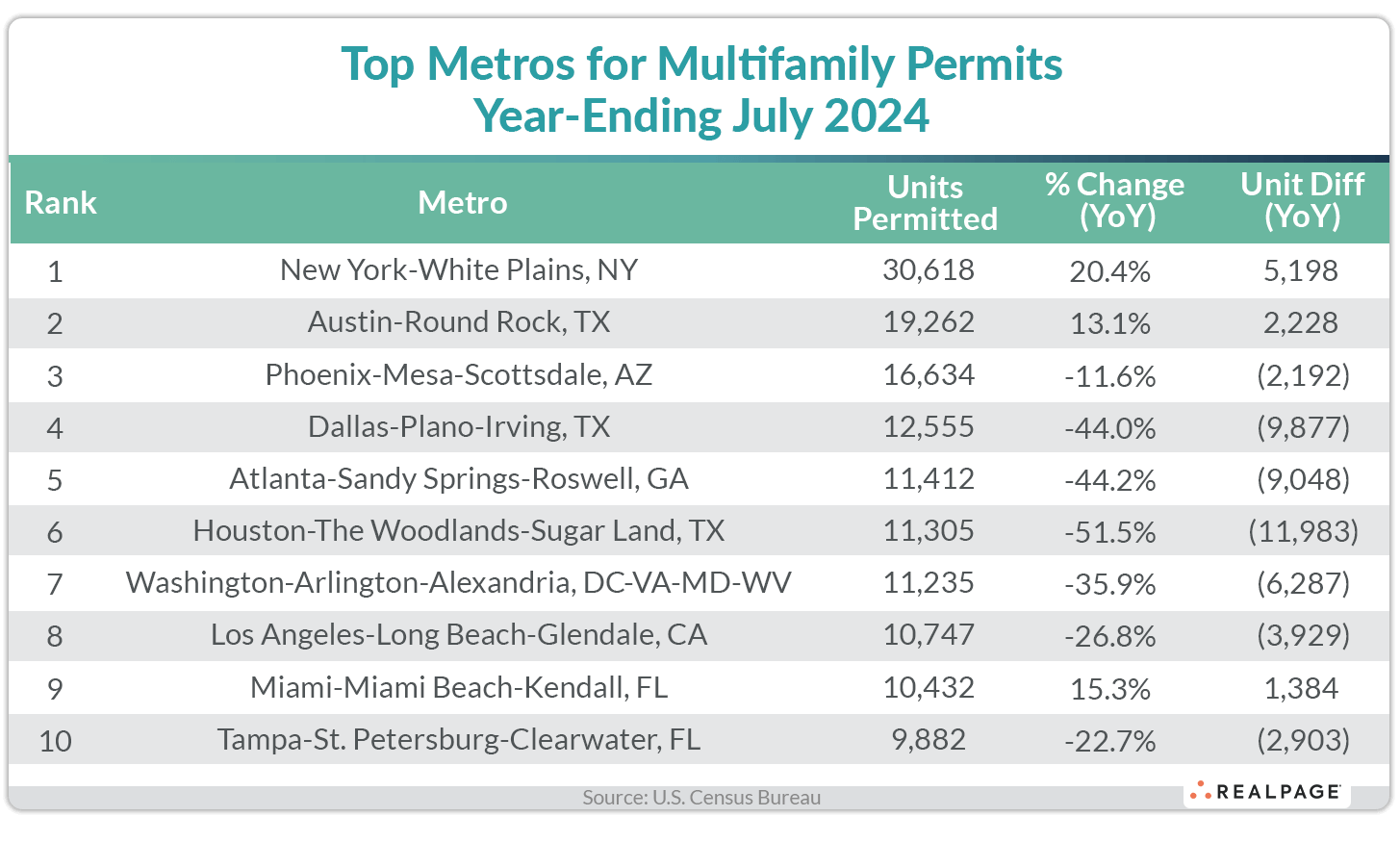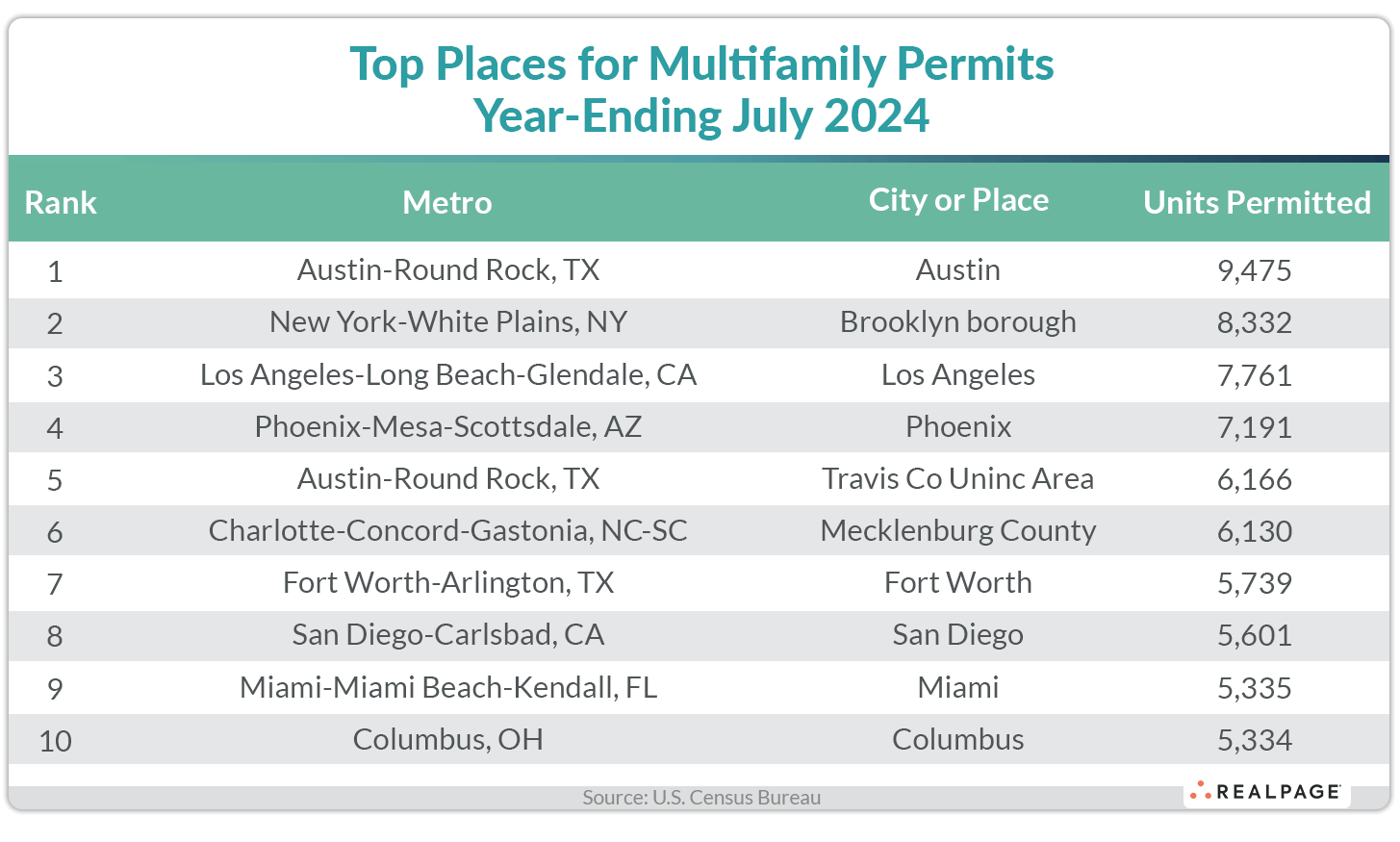Multifamily Starts Increase in July as Permitting Slows

Multifamily starts increased suddenly and sharply in July, while multifamily permitting declined.
Annualized multifamily starts jumped to 363,000 units in July, up 11.7% from June’s seasonally adjusted annual rate (SAAR), according to the latest report from the U.S. Census Bureau and the Department of Housing and Urban Development. However, starts were still down 21.8% from the same time last year. Multifamily permitting decreased 12.4% for the month and 18.2% for the year to 408,000 units.
Despite the recent jump, multifamily starts (and permits) continued to slow from peak levels seen in 2022. Multifamily permitting appears to be leveling off close to the average of about 420,000 units from 2013 to 2020, while starts averaged 360,000 units over that period.
The annualized rate for multifamily completions continued to exceed both permits and starts with the SAAR for July at 473,000 units, a drop of 24.4% from June but up 49.2% from last July. Additionally, the number of multifamily units currently under construction slipped 1.5% for the month to 870,000 units, 13.3% less than last year. The number of multifamily units authorized, but not started (which excludes cancelled, abandoned, expired and revoked permits was essentially unchanged from last month and July of last year.
Meanwhile, single-family starts were down 14.1% from last month and 14.8% for the year to their lowest level since March 2023 at 851,000 units. The annualized rate for single-family permitting also declined slightly for the month (-0.1%) and was 1.6% lower than last July at 938,000 units.
Single-family completions were up 0.5% for the month and up even more (3.6%) for the year to 1.054 million units. The number of single-family units under construction declined 2.1% from June to 653,000 units and were down 4.1% from one year ago. Single-family units authorized, but not started totaled 143,000 units, up 5.1% for the month and 4.4% for the year as weather challenges across the country hindered starts.
Together with the small two-to-four unit figures, total residential permitting decreased 4% from last month and were down 7% for the year to 1.396 million units. Despite July’s increase in annual multifamily starts, the SAAR of total residential starts was down 6.8% from last month to 1.238 million units and they were down 16% from last year.
Compared to one year ago, the annual rate for multifamily permitting decreased in three of the four Census regions. The deepest decline in annualized multifamily permitting occurred in the West region (down 28.9% to 92,000 units), while the South region declined 20.4% to 200,000 units and the Midwest region was down 16.3% to 53,000 units. The Northeast region was up 13.7% from one year ago with 65,000 units permitted. Compared to the previous month, permitting was down in the same three regions and up in the Northeast region.
Multifamily starts increased dramatically for the year in the small Northeast region (up 125.3% to 107,000 units). The West was down 63.3% to 49,000 units and the Midwest was down 33.3% to 33,000 units, while the South was down 25.5% to 174,000 units. Compared to June’s SAAR, starts were down in the South and Midwest, up moderately in the South, and more than doubled in the Northeast region.
Metro-Level Multifamily Permitting
All the top 10 markets from June’s list returned in July with the first five remaining in order.
New York remained the top multifamily permitting market in the 12-months-ending in July with 30,618 units permitted, up about 20% from last year and up more than 5% from June. Austin returned at #2 with 19,262 units permitted, up about 13% from last year and about 2% from last month.
Phoenix remained in the #3 spot, permitting a total of 16,634 units for the year, down 5.3% from June and about 12% less than last July. Multifamily permitting continues to slow rapidly in Dallas with 12,555 units permitted, 9,877 units less than last year and almost 1,100 units less than June’s total. Still, Dallas remained in the #4 spot nationally.
Atlanta also remained in place at #5 with 11,412 units permitted through July, but that was down 9,048 units from last year’s pace. Houston moved up two spots from last month to #6 with 11,305 units permitted for the year, less than half the market’s pace one year ago, but close to June’s total. Washington, DC and Los Angeles each slipped one spot to #7 and #8, respectively with permitting totals close to 11,000 units each.
Miami and Tampa returned to the #9 and #10 spots again this month, permitting 10,432 units and 9,882 units, respectively. Miami was up for the year but down slightly for the month, while Tampa declined for both.
All but three of the top 10 multifamily permitting markets decreased annual totals from the year before and some were pretty significant declines. Houston had the deepest decrease in annual multifamily permitting of the top 10 (-11,983 units), followed by Dallas (-9,877 units), Atlanta (-9,048 units), Washington, DC (-6,287 units), Los Angeles (-3,929 units), Tampa (-2,903 units) and Phoenix (-2,192 units). Miami and Austin had moderate increases of around 1,300 to 2,200 units, while New York jumped almost 5,200 units from last year.
Other major non-top 10 markets with significant declines in annual permitting include San Antonio (-8,737 units), Raleigh/Durham (-5,792 units), Minneapolis/St. Paul (-5,037 units), Jacksonville (-4,938 units), Portland, OR (-4,753 units), Denver (-3,166 units), Orlando (-3,138 units) and Riverside (-3,051 units).
Major markets with significant year-over-year increases in annual multifamily permitting in the year-ending July were San Diego (+3,018 units), Fort Worth (+2,781 units), Greensboro/Winston-Salem (+1,394 units), Omaha (+1,317 units), Ashville, NC (+1,192 units) and Milwaukee (+1,037 units).
The annual total of multifamily permits issued in the top 10 metros – 144,082 – was about 21% less than the 181,491 issued in the previous 12 months and down 1.4% from last month. The total number of permits issued in the top 10 metros was almost equal to the number of permits issued for the #11 through #35 ranked metros.
Below the metro level, nine of last month’s top 10 permit-issuing places returned to this month’s list with only two remaining in the same place. The list of top individual permitting places (cities, towns, boroughs and unincorporated counties) generally include the principal city of some of the most active metro areas.
The city of Austin remained in the #1 position with 9,475 units permitted, about the same as in June. The borough of Brooklyn moved up two spots to #2 with 8,332 units permitted, 1,241 units more than June’s annual total. The cities of Los Angeles and Phoenix moved down one spot each to #3 and #4 with 7,761 units and 7,191 units permitted, respectively. Both were down about 300 to 500 units from June.
Unincorporated Travis County (Austin) moved up three spots to #5 with 6,166 units permitted through July, 644 more units than last month. Mecklenburg County (Charlotte) remained in the #6 spot, permitting 6,130 units for the year, up 189 units from June. The city of Fort Worth improved three spots to #7, permitting 5,739 units for the year, while the city of San Diego slipped three spots to #8 with an annual total of 5,601 units permitted.
The city of Miami dropped two spots to #9 in July, permitting 5,335 units for the year, a 10% decrease from last month. The city of Columbus, OH made it on the top 10 list at #10 with 5,334 units permitted, just one unit less than Miami.
While Texas still accounted for six of the top 20 individual permitting places on July’s list, the cities of Houston and Dallas and Harris County (Houston) have been moving down toward the bottom of the top 20 list. Meanwhile, the cities of Columbus and Seattle, and the boroughs of Brooklyn and Manhattan have been moving up. In addition to Texas’ six permitting places among the top 20, New York garnered three places, while Florida, California and North Carolina each had two permitting places on the top 20 list.










